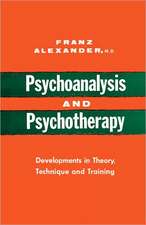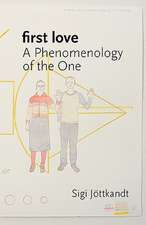The Groups Book: Psychoanalytic Group Therapy: Principles and Practice: Tavistock Clinic Series
Autor Caroline Garlanden Limba Engleză Paperback – 31 dec 2010
Din seria Tavistock Clinic Series
-
 Preț: 267.80 lei
Preț: 267.80 lei - 5%
 Preț: 299.73 lei
Preț: 299.73 lei - 5%
 Preț: 267.46 lei
Preț: 267.46 lei - 5%
 Preț: 266.48 lei
Preț: 266.48 lei - 5%
 Preț: 268.29 lei
Preț: 268.29 lei -
 Preț: 311.91 lei
Preț: 311.91 lei - 5%
 Preț: 182.34 lei
Preț: 182.34 lei - 5%
 Preț: 261.22 lei
Preț: 261.22 lei - 5%
 Preț: 276.82 lei
Preț: 276.82 lei - 5%
 Preț: 223.35 lei
Preț: 223.35 lei - 5%
 Preț: 274.60 lei
Preț: 274.60 lei - 5%
 Preț: 204.81 lei
Preț: 204.81 lei - 5%
 Preț: 145.14 lei
Preț: 145.14 lei - 5%
 Preț: 251.31 lei
Preț: 251.31 lei - 5%
 Preț: 266.87 lei
Preț: 266.87 lei - 5%
 Preț: 273.91 lei
Preț: 273.91 lei - 5%
 Preț: 267.28 lei
Preț: 267.28 lei -
 Preț: 246.40 lei
Preț: 246.40 lei - 5%
 Preț: 246.49 lei
Preț: 246.49 lei - 5%
 Preț: 268.88 lei
Preț: 268.88 lei - 5%
 Preț: 218.74 lei
Preț: 218.74 lei -
 Preț: 176.33 lei
Preț: 176.33 lei - 5%
 Preț: 268.34 lei
Preț: 268.34 lei - 18%
 Preț: 816.36 lei
Preț: 816.36 lei - 18%
 Preț: 816.86 lei
Preț: 816.86 lei - 11%
 Preț: 818.77 lei
Preț: 818.77 lei - 5%
 Preț: 296.84 lei
Preț: 296.84 lei - 17%
 Preț: 219.44 lei
Preț: 219.44 lei - 11%
 Preț: 813.45 lei
Preț: 813.45 lei - 5%
 Preț: 1025.06 lei
Preț: 1025.06 lei - 17%
 Preț: 220.97 lei
Preț: 220.97 lei - 18%
 Preț: 818.15 lei
Preț: 818.15 lei - 16%
 Preț: 223.15 lei
Preț: 223.15 lei - 5%
 Preț: 252.44 lei
Preț: 252.44 lei - 11%
 Preț: 813.45 lei
Preț: 813.45 lei - 16%
 Preț: 223.68 lei
Preț: 223.68 lei - 17%
 Preț: 819.14 lei
Preț: 819.14 lei - 18%
 Preț: 815.57 lei
Preț: 815.57 lei
Preț: 348.43 lei
Preț vechi: 366.77 lei
-5% Nou
66.73€ • 68.75$ • 55.90£
Carte disponibilă
Livrare economică 03-17 februarie
Livrare express 17-23 ianuarie pentru 40.55 lei
Specificații
ISBN-10: 1855758504
Pagini: 442
Dimensiuni: 147 x 230 x 25 mm
Greutate: 0.7 kg
Ediția:1
Editura: Taylor & Francis
Colecția Routledge
Seria Tavistock Clinic Series
Locul publicării:Oxford, United Kingdom
Public țintă
Professional Practice & DevelopmentCuprins
Notă biografică
Caroline Garland is a consultant clinical psychologist and psychoanalyst, who founded the Unit for the Study of Trauma and Its Aftermath in the Adult Department of the Tavistock Clinic. She has worked for over fifteen years with a number of colleagues specialising in the theoretical understanding and the psychotherapeutic treatment of trauma.
Recenzii
Descriere
The treatment manual is intended to serve more than one purpose. It is designed to be a research tool, making possible the standardization and validation of a treatment method. It is also a highly condensed primer and a practicum, offering a description of psychoanalytic group therapy which will act as a handbook for the beginner and as an "aide-memoire" for the more experienced therapist. Many therapists will have had some experience with individual patients but wonder how they are to convert that knowledge into the practicalities of running a group, in which seven or eight patients are seen simultaneously. For young practitioners in a National Health Service setting, this can be a daunting prospect. It is difficult to do group therapy well, yet when it is done well it provides an invaluable therapeutic medium for a collection of patients it might be neither possible nor wise nor even necessary to see in individual treatment. In other words, there are many patients for whom a group is the treatment of choice.

















